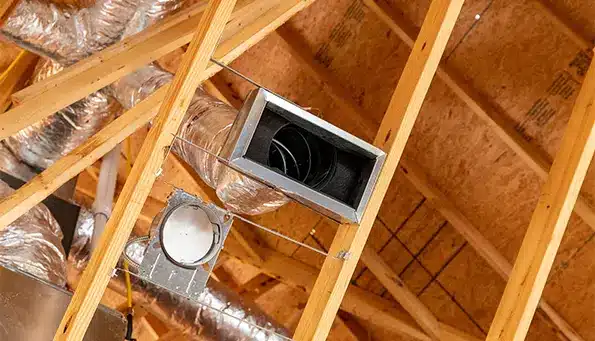
Should Wet Insulation Be Replaced?
Insulation is key in keeping your home comfortable and reducing energy usage. But it also faces various threats, with moisture being chief among them. Wet
Air Duct Sealant & Repair
Fill out the form or call at
Air ducts are more likely to leak than you would think. Most people are unaware that almost 99% of the air ducts in homes have up to 44% of leakage. According to the Department of Energy, there is enough air leakage in the average home to leaving a medium-sized window wide open. Luckily, this doesn’t have to be the case for you.
If you haven’t checked the air ducts in your home lately, you might want to consider calling a specialist. Call Attic Projects and our air duct specialists will thoroughly inspect and assess where the leaking is coming from. We will work relentlessly to seal any leaks to keep you and your home comfortable and safe.

There are some telling signs you should be on the lookout for if you think you may have a leak in the air ducts in your home. If you are experiencing any of the following issues, call Attic Projects immediately for a FREE inspection of your air ducts.
Sealing air ducts will prevent leakage leading to a cut in the amount of energy your home uses. When you cut the amount of energy your home uses, you are cutting down the amount of energy that the source (likely a power plant) uses. Ultimately, you are contributing to the decrease of pollution due to less energy being produced.
Are there rooms that are too hot in the summer, but too cold in the winter but the rest of your home is evenly controlled throughout? When you seal your air ducts, you can distribute the air more efficiently, and then every room will maintain a consistent temperature.
Leaking air ducts can raise utility bills. If your systems are working inefficiently, your utility bills can go down up to 20%! Getting an air duct specialist to fix your systems, will pay itself off in no time with the money you will be saving monthly.
Unfortunately, fumes from chemicals and insulation are likely to end up in your air ducts. When your air ducts are leaking, these fumes can end up being distributed throughout your home, instead of filtered out if there were no leaks. These fumes can lead to more aggressive allergies and increase the risk of asthma. Seal your air ducts and improve the quality of your air.
If your home uses gas appliances, like furnaces or water heaters, these appliances can release combustion gases. If your air duct is leaking, these gases can be blown throughout your home through “back drafting.” Keep the fumes from getting into your home by calling an air duct specialist today to make sure your air ducts are working properly.
Attic Cleaning | Attic Sanitation | Mold Remediation | Attic Insulation Installation | Attic Insulation Removal | Radiant Barrier Insulation | Air Duct Sealant & Repair | Rodent Proofing & Removal | Attic Remodeling & Storage | Attic Stairs & Doors
If you suspect that your air ducts are underperforming, you may need to call Attic Projects to inspect them. Our air duct professionals will seal your air ducts and prevent leakage from happening. Ultimately, this will save you money and make a safer and more comfortable home for your family.

Crawl Space Cleanup | Crawl Space Insulation Installation | Crawl Space Insulation Removal | Vapor Barrier | Crawl Space Doors
Orange County | Everett | Bellingham | San Diego | Mt. Vernon | Tacoma | Seattle


Yes. If your air ducts are leaking, the efficiency of your heating and cooling systems will be affected. Air will be leaking into the wrong areas, meaning one room may not be getting the air it needs to cool down, where another room may be too cold.
No, but your air quality will be! The fumes from the gas can get trapped in the air ducts and distribute throughout your home. This is known as “back-drafting.” This can be harmful to you and your family. If you have gas appliances, contact Attic Projects today to get a free inspection of your air ducts.
Air particles and chemicals can easily get into your air ducts if they have leaks. These particles and chemicals are then released into the air of your home, making the air quality poor for asthmatics and those with allergies. Sealing your air ducts will resolve these issues and result in better air quality.
Yes! Sealing your air ducts can help improve your air conditioning distribution and heating, making your systems work less. This results in overall lower energy bills. Contact Attic Projects today to start saving money!
We doubt that you’ll need us again, but if you do — we got you covered.

*Insulation materials qualify for our 20 Year Warranty

We doubt that you’ll need us again, but if you do — we got you covered.
*Insulation materials qualify for our 20 Year Warranty
Rodents are a nightmare for any homeowner. They can lower the value of your home by causing serious damage, foul odors, and extensively unsanitary conditions. They also pose a significant health risk to you and your family by spreading disease and causing illness. The last thing you want is to waste your time removing rodents, only to have them move right back in. At Attic Projects, we not only humanely remove the rodents and pests from your home, but we also rodent-proof your home so they can’t come back. In order to keep the pests and rodents out permanently, you have to close up every entry point that they may squeeze into. Call Attic Projects today to get your free estimate.
Fill out the form or call us at

Insulation is key in keeping your home comfortable and reducing energy usage. But it also faces various threats, with moisture being chief among them. Wet

Summer may be a time of refreshing swims and exciting road trips, but the season also brings many challenges for homeowners. In particularly humid climates,

HISTORY OF FIBERGLASS INSULATION Fiberglass insulation, a material widely used in modern construction, has a history that dates back to the 1930s. The Owens Corning
